Physical Address
304 North Cardinal St.
Dorchester Center, MA 02124
Physical Address
304 North Cardinal St.
Dorchester Center, MA 02124
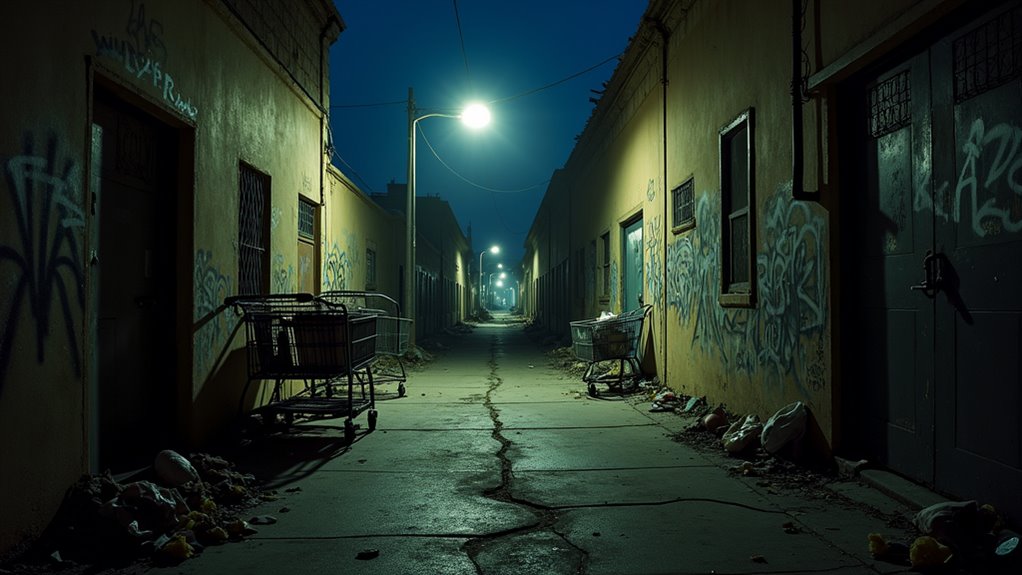
Once considered charming neighborhoods, these nine Los Angeles danger zones now reveal a troubling reality visitors rarely expect.
If you’re planning a trip to Los Angeles, knowing which areas to approach with caution can make all the difference in your experience. While the City of Angels offers stunning beaches, world-class entertainment, and iconic landmarks, it also harbors neighborhoods where crime rates tell a different story. You’d want to familiarize yourself with these trouble spots before exploring LA’s sprawling urban landscape. Understanding where and when safety concerns peak might just save you from turning your dream vacation into something far less pleasant.
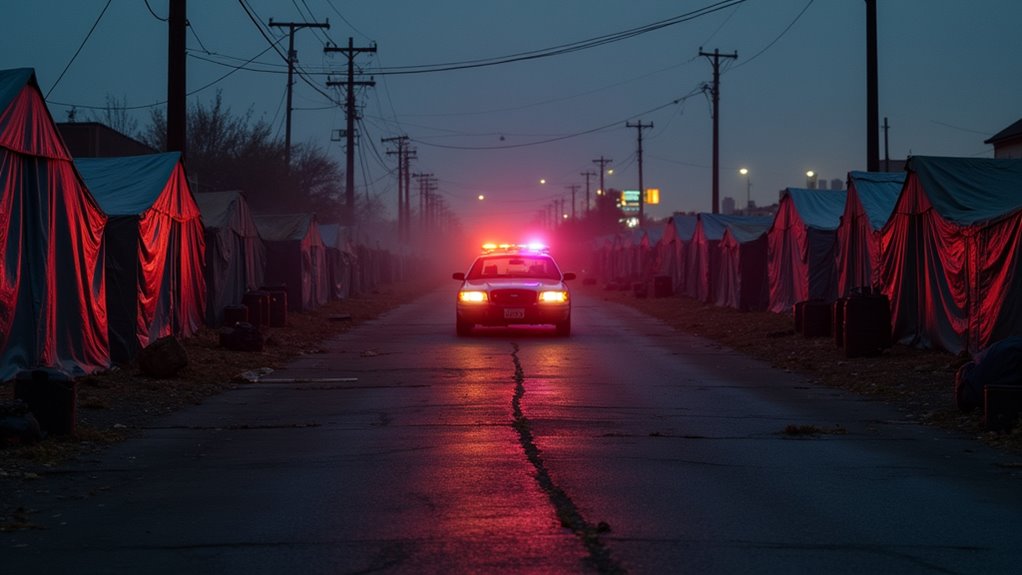
When you venture into Skid Row, you’re entering what many consider the most dangerous neighborhood in Los Angeles. Bound by Los Angeles Street, Central Avenue, 4th Street, and 8th Street, this area houses 9,000-15,000 homeless individuals in challenging conditions.
Skid Row: LA’s most treacherous neighborhood, where thousands struggle to survive amid constant danger.
The statistics are alarming: violent crime rates hit 48.13 incidents per 1,000 residents annually, 201% higher than the national average. Property crime isn’t far behind at 97.49 incidents per 1,000 residents.
Your risk peaks between 9 PM and 3 AM when drug and gang violence escalates. Poor lighting and sprawling encampments make navigation unpredictable and dangerous. Skid Row consistently ranks among the top five most dangerous areas in the entire city. Recent crime reports from July 2024 confirm the area remains highly unsafe with ongoing incidents.
Despite being a hub for social services, Skid Row struggles with insufficient resources to address its rampant poverty, drug use, and crime problems.
Downtown Los Angeles transforms dramatically after sunset, shifting from a bustling commercial hub to a more sinister environment that demands your vigilance. The Fashion District becomes particularly hazardous, with violent crime rates soaring 204% above the national average.
You’ll face increased risks of muggings, theft, and assaults as crowds disperse in the evening. Recent shooting incidents near Griffith Ave and S Union Ave highlight the area’s volatility. This area recently recorded 17 homicides, making it one of the most dangerous parts of the city.
With violent crime at 21.62 incidents per 1,000 residents and property crime at 76.18, you’re entering a high-risk zone after dark.
While generally safe during daylight hours due to police presence and foot traffic, you should avoid carrying valuables and remain alert to your surroundings once businesses close and the streets empty. Unlike Ohio’s venomous snakes which are rare and typically avoid humans, the threats in Downtown LA are far more unpredictable and prevalent.
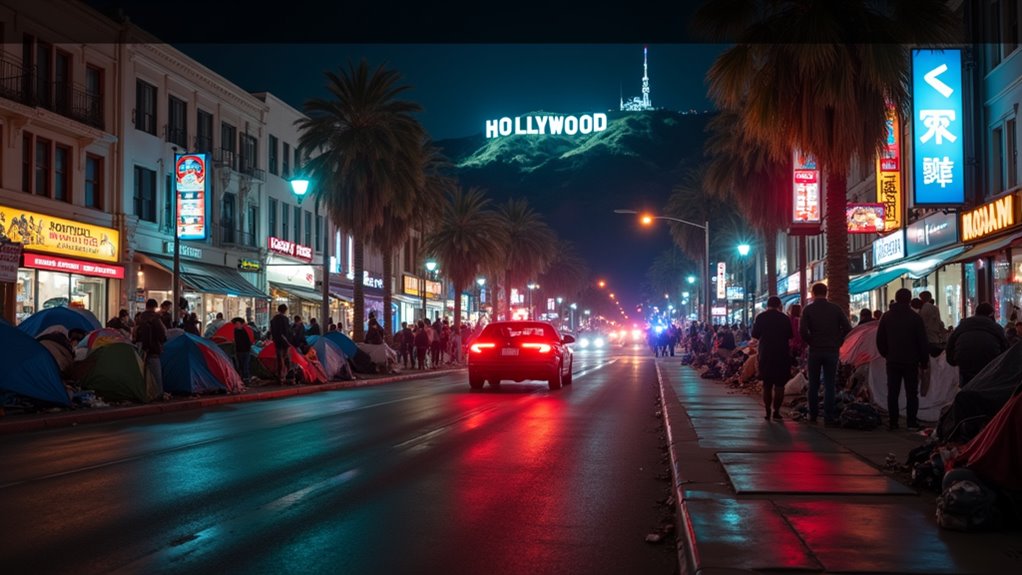
Hollywood Boulevard, once the glittering symbol of star-studded glamour, now presents visitors with a complex reality where celebrity allure meets urban challenges. You’ll find the area relatively safe during daylight hours when police presence is strong and crowds are abundant, but exercise caution after dark.
Property crimes dominate here, with pickpocketing and petty theft common in crowded tourist spots. While taking photos with costumed characters or admiring the Walk of Fame, stay alert to your surroundings. For a complete change of scenery and safer outdoor adventures, consider visiting the mountain peaks near Florida instead.
The boulevard’s vibrant nightlife can blur safety boundaries, especially with the area’s visible homelessness and occasional vagrancy issues. If you’re exploring Hollywood at night, stick to well-lit areas and consider joining guided tours for added security. The best time to visit for optimal safety is between 10 AM and 10 PM when the area maintains its vibrancy while offering better security conditions.
South Los Angeles presents visitors with some of the city’s most challenging neighborhoods, where historical disinvestment has contributed to persistent safety concerns.
The area has recently seen a surge in violent crimes, particularly homicides and aggravated assaults. Gang activity remains a significant factor, driving auto parts theft and other property crimes. Similar to New Orleans’ dangers, many high-risk areas in South Los Angeles show patterns of concentrated crime activity.
You’ll notice that certain neighborhoods experience higher crime rates than others, making uniform safety assessments difficult. The lack of detailed statistics on crime rates across different age groups makes it challenging to determine if younger generations are contributing less to these issues.
Local businesses struggle against theft and vandalism, creating a cycle that further limits economic opportunities. While law enforcement has increased overall arrests, they’ve faced challenges in addressing specific crimes like motor vehicle theft.
If you’re visiting, remain vigilant, especially after dark, and consider exploring with residents who know which areas to avoid. Community programs are working to address these issues, but progress takes time.
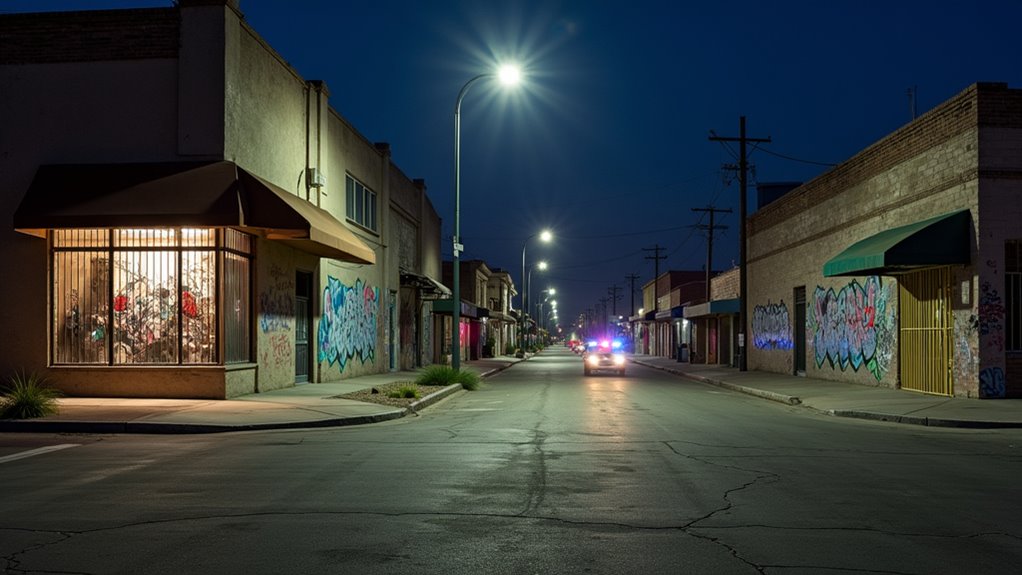
Known for its complex history and cultural significance, Compton presents visitors with unique challenges that require awareness and context. With a crime rate of 38 per 1,000 residents, it ranks among America’s highest crime communities, though community efforts continue to drive positive change.
When visiting Compton, keep these realities in mind:
Visitors should exercise particular caution around major thoroughfares like Compton Boulevard, Long Beach Boulevard, and Alameda Street, which are known crime hotspots.
Despite its challenges, Compton has produced influential figures in music and sports while maintaining a prosperous cultural heritage. Similar to New Orleans, implementing essential safety tips can significantly enhance your security when exploring neighborhoods with higher crime rates.
While Koreatown boasts vibrant culture and renowned restaurants, its safety challenges shouldn’t be overlooked by visitors and residents alike. The neighborhood sits in the 7th percentile for safety nationwide, with crime rates 32% above the national average.
You’ll face greater risks in eastern parts of Koreatown and during late-night hours, especially near nightlife venues. Most concerning are the assault and robbery rates—7.7 and 3.9 incidents per 1,000 residents respectively. Property crimes and drug offenses are also common issues you’ll need to watch for. The projected murder cost per resident of $192 exceeds both the US and Los Angeles city averages, highlighting the neighborhood’s elevated crime impact. As with any urban area, maintaining situational awareness while exploring the neighborhood significantly improves your safety outcomes.
When exploring Koreatown, avoid traveling alone at night, stick to well-lit areas, and use reliable transportation. The southwest section offers relatively safer conditions, though remaining alert throughout the neighborhood is essential regardless of location.
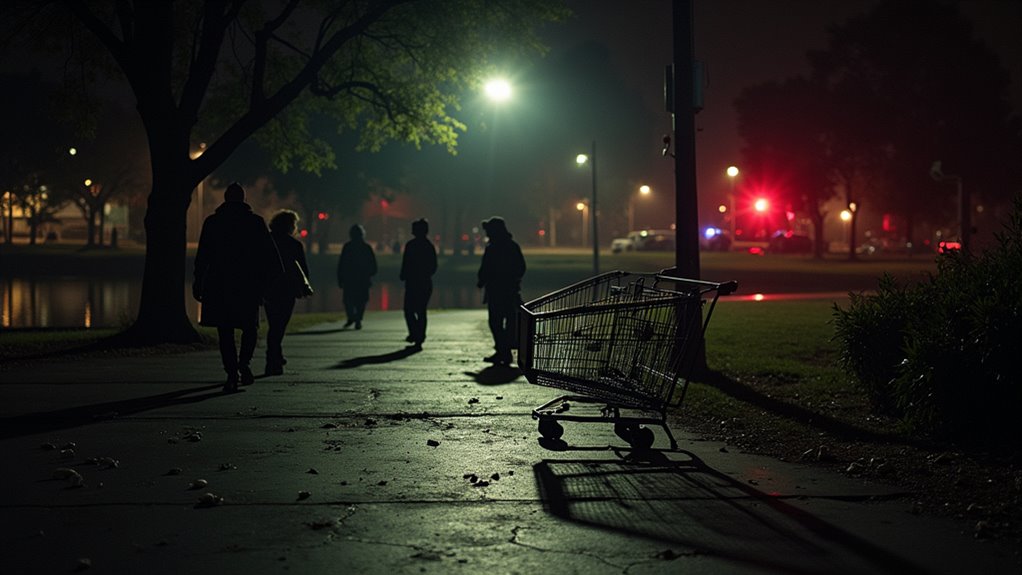
MacArthur Park presents a complex safety landscape that’s undergoing significant transformation. Recent statistics show a 46% drop in crimes against persons, with visible improvements following city interventions.
You’ll notice increased police presence has disrupted what was once an open-air market for drugs and stolen goods.
If you’re visiting this area, be aware of:
Law enforcement recently recovered $350,000 worth of stolen retail merchandise from a nearby storefront on West 6th Street.
While significant progress has been made through collaborative efforts between LAPD and community organizations, remain vigilant when visiting MacArthur Park.
Those seeking affordable destinations might want to consider other parts of California or neighboring states for budget-friendly travel experiences.
Historically notorious for its gang presence, Boyle Heights has seen substantial improvements in safety, with LAPD data showing a remarkable 65% reduction in homicides within the Hollenbeck Division.
Despite this progress, you’ll find crime rates here still sit 119% above the national average for violent crime.
While arrests have dropped by half since 2010, the neighborhood remains an LAPD priority for violence prevention.
The area saw 40 homicides in 2024, though that number has fallen to just 14 in 2024 so far.
Community programs like GRYD and the Community Safety Partnership have contributed significantly to a 40% homicide drop in the areas where they are actively engaged.
If you’re visiting, be particularly cautious during summer months when arrest rates peak.
Visitors seeking a safer outdoor experience might consider exploring Montana’s landscapes instead of navigating Los Angeles’ more dangerous neighborhoods.
Remember that Boyle Heights connects to other high-risk areas like Lincoln Heights and El Sereno, so stay vigilant throughout this eastern Los Angeles district.

Beneath Venice Beach’s iconic palm trees and vibrant boardwalk culture lurks a troubling reality that many travelers don’t anticipate. With crime rates 177-182% above the national average and a D+ safety grade, your 1-in-17 chance of becoming a victim demands caution. The area’s total crime rate stands at 160% above the national average, confirming its dangerous reputation.
Venice Beach’s postcard perfection masks alarming danger—crime rates soar 177% above average and visitors face serious risk.
Your highest risks occur in:
While Abbott Kinney Boulevard remains relatively secure, you’ll want to stick to daytime exploration, avoid solo ventures after sunset, and secure valuables. Taking safety precautions similar to those recommended for island destinations can significantly reduce your risk when visiting this area. Despite increased policing efforts, the area’s persistent safety issues haven’t improved noticeably.
While Los Angeles offers incredible experiences, you’ve now got the 411 on its riskier neighborhoods. Don’t cross these areas off your map completely—just approach with caution, especially after dark. Keep your street smarts dialed up, trust your instincts, and avoid flashing valuables. With proper awareness and local intel, you’ll navigate LA safely while still enjoying everything this dynamic city has to offer.